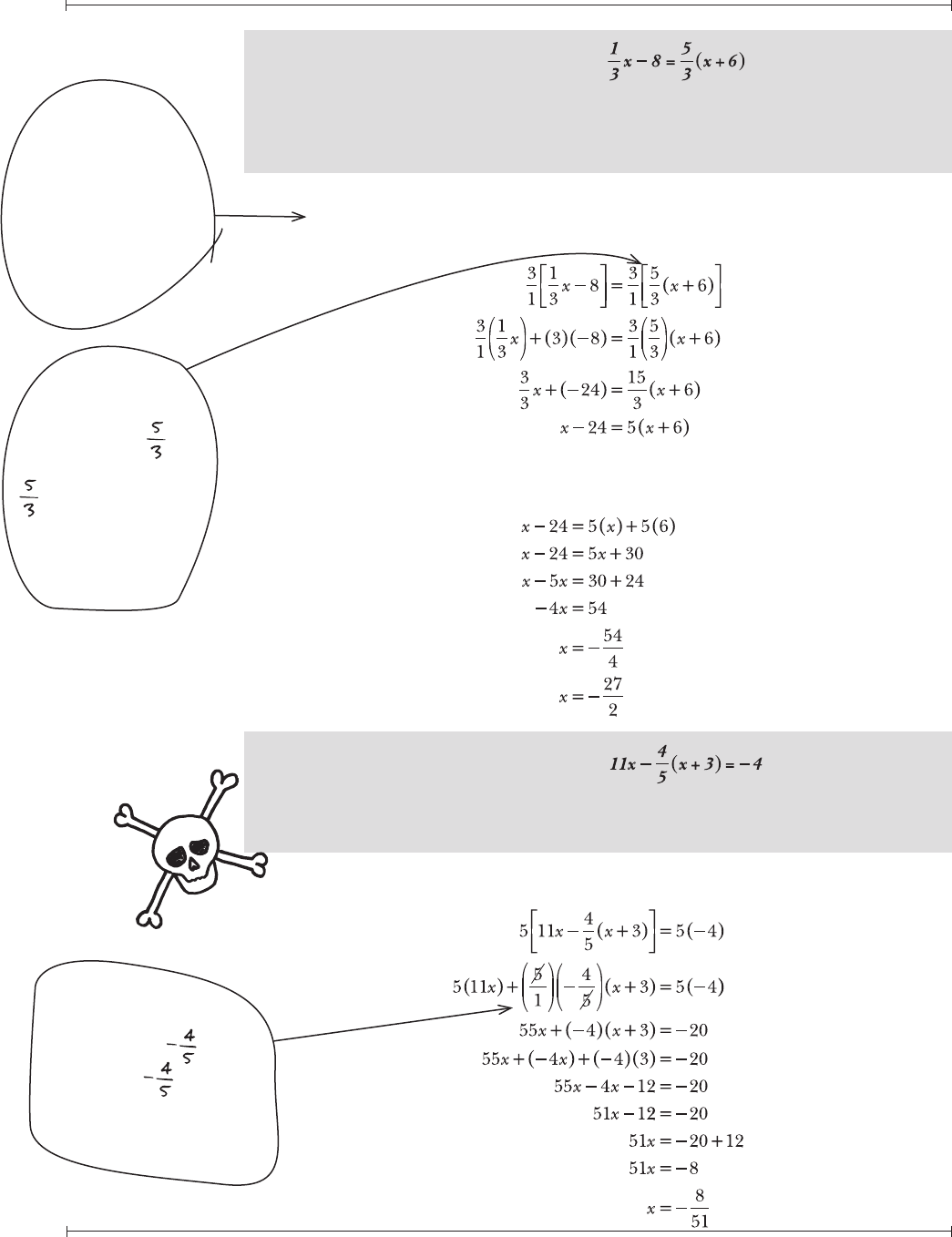
Chapter Four — Linear Equations in One Variable
The Humongous Book of Algebra Problems
66
Note: Problems 4.21–4.23 refer to the equation .
4.23 Create an equivalent equation by eliminating the fractions and verify that
its solution matches the solution generated in Problem 4.21 and verified in
Problem 4.22.
Eliminate the fractions in an equation by multiplying every term by the least
common denominator. The fractions in this equation both have the same
denominator, 3, the LCD by default.
All the fractions have been eliminated from the equation. Solve the resulting
equation for x.
Note: Problems 4.24–4.25 refer to the equation .
4.24 Create an equivalent equation by eliminating the fraction and solve that
equation for x.
Use the method described in Problem 4.23 to eliminate the fraction: Multiply
each term of the equation by 5, the least common denominator.
This gets
a little tricky
when the least
common denominator
contains variables,
and that’s discussed
in Problems 20.9–
20.19.
(x + 6)
is already
multiplied by
,
so when you multiply
by 3, you multiply
everything inside
(x +6) by 3 as
well.
(x + 3) is already
multiplied by
, so
multiplying
by 5
automatically multiplies
everything inside
(x + 3) by 5.

Chapter Four — Linear Equations in One Variable
The Humongous Book of Algebra Problems
67
Note: Problems 4.24–4.25 refer to the equation .
4.25 Solve the equation for x without eliminating the fractions in the original
equation. Verify that the solution is equal to the solution generated in Problem
4.24.
Apply the distributive property to simplify the left side of the equation and then
isolate x on that side of the equal sign.
Combine like terms on both sides of the equal sign using the least common
denominator 5.
4.26 Express the rational number as a fraction.
If a decimal contains a repeating string of digits that begins immediately to the
right of the decimal point, in the tenths place, apply the technique described
in Problems 2.20–2.21 to convert the decimal into a fraction. The decimal
, however, requires a slightly more rigorous approach.
Set x equal to the repeating decimal.
x = 0.9444444444…
Multiply both sides of this equation by 10
n
, where n is the number of digits in
the repeating string. Here, the single digit 4 repeats infinitely, so n = 1.

Chapter Four — Linear Equations in One Variable
The Humongous Book of Algebra Problems
68
Subtract the original equation (x = 0.9444444444…) from the modified
equation (10x = 9.444444444…).
Express 8.5 as an improper fraction, using the technique described in Problem
2.19.
Eliminate the coefficient of x to solve for x and thereby express
x = 0.9444444444… as a fraction. The equation contains a fraction, so rather
than divide both sides by 9, multiply both sides by the reciprocal of 9.
4.27 Express the rational number as a fraction.
Apply the technique described in Problem 4.26. The repeating string in this
decimal consists of one digit (3), so subtract the equation x = 0.5833333333…
from 10
1
(x) = 10
1
(0.5833333333…).
Express 5.25 as an improper fraction and solve the equation for x.
When you
subtract, assume
that all the innitely
many 4s on top cancel
out the innitely
many 4s below. That
means the equation
boils down to this
subtraction problem:
9.4 – 0.9 = 8.5.

Chapter Four — Linear Equations in One Variable
The Humongous Book of Algebra Problems
69
Express the fraction in lowest terns.
4.28 Express the rational number as an improper fraction.
Apply the technique described in Problem 4.26. The decimal 6.13939393939…
contains a two–digit repeating string, so subtract the equation
x = 6.13939393939 from 10
2
(x) = 10
2
(6.1393939393939).
Express 607.8 as an improper fraction and solve the equation for x.
Express the fraction in lowest terms.
You multiply
by 10 to the
SECOND power
because TWO digits
(3 and 9) repeat
innitely.
..................Content has been hidden....................
You can't read the all page of ebook, please click here login for view all page.
